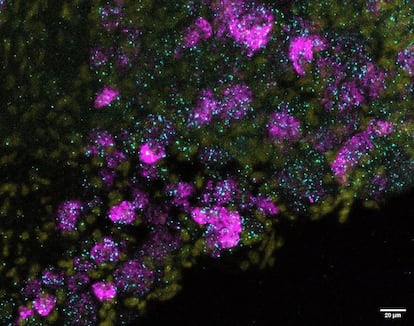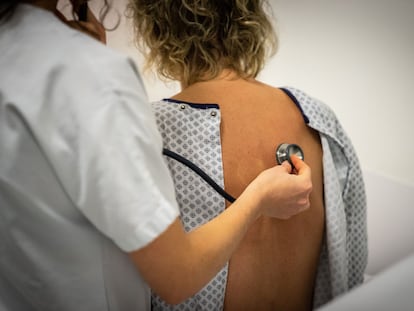Scientists discover new protein involved in our sense of touch
Experiments on mice and human cells uncover a previously unknown element that impacts tactile sensation

The skin is the human body’s largest organ. A person’s skin can take up two square meters, weigh up to 11 pounds and be as thick as one centimeter, in the soles of the feet, or as thin as .02 inches, in the scrotum. It is the interface through which we humans relate to our environment, allowing us to sense everything from cold to burns, shocks to shapes. In the skin’s three main layers, particularly the epidermis, there are more than 11,000 proteins, the majority with functions that are yet to be discovered. Now, a group of researchers has discovered one, called ELKIN1, which seems to be essential to our sense of touch, the least-studied sense. Without ELKIN1, we might not be able to feel a caress from our loved ones.
Gary Lewin of the Max Delbrück Center for Molecular Medicine (Berlin, Germany) has spent more than 20 years researching ionic channels, proteins that are present in the membrane, epidermis and cells. They have the ability to open, allowing the exchange of ions between a cell’s interior and exterior. They have different functions depending on the cell type. In the case of sensory neurons, the channels convert a given stimulus (heat, cold, pressure) into ionic currents (similar to electrical currents) that reach from the most peripheral nerve endings to the brain. In 2020, studying melanoma tissues, a researcher in the Laboratory of Molecular Physiology of Somatic Sensations that Lewin directs discovered a protein that gave mechanical sensitivity to these cancer cells. “We discovered that they possess ion channel activity very similar to that found in tactile receptors. We identified ELKIN1 as the cause of this activity. The next step was obvious, to see if it had anything to do with touch,” says the lead author of the study, who just a few years ago discovered that shaved mice are insensitive to certain kinds of pain.
To prove it, they carried out a series of experiments with mice and human cells, whose results were recently published in Science magazine. The rodents’ ELKIN1 gene was modified using the CRISPR technique so that they did not express the foundational protein. Then, researchers tickled their hind legs with a cotton swab. They found that the unmodified mice pulled away 90% of the time. However, the mutant mice only pulled away 47.5% of the time, suggesting a loss of sensitivity to the mechanical stimuli.

“ELKIN1 plays an important role in touch,” says Óscar Sánchez, who works in the Lewin laboratory and is a co-author of the study. “But there are other ionic channels, like PIEZO2. It’s highly probable that in the cases of the mutant rats who displayed a response to the mechanical stimuli, PIEZO2 was compensating for the absence of the other channel,” he says. In October 2021, researchers David Julis and Ardem Patapoutian were awarded the Nobel Prize for Medicine. The former had discovered temperature receptors. The latter had been the first to describe the pressure sensing channels PIEZO1 and PIEZO2. One regulates the sensation of pressure in the internal organs, breath and the bladder’s control of urine. The other, in addition to proprioception, the sense that allows you to close your eyes and touch your nose, is key to the sense of touch. If the latest findings are confirmed, they will show that PIEZO2 and ELKIN1 work in tandem.
According to Lewin, “They play complementary roles, each representing approximately 50% of touch.” If that proves to be true, different tactile sensations stemming from the outside world reach the endings of sensory neurons that, starting from the spinal ganglia, connect to the epidermis. There, the PIEZO2 and ELKIN1 channels, either overlapping or combined, convert touch into an ionic current that travels up the nervous system until it reaches the brain, which is responsible for interpreting whether what it is feeling is a light touch or a blow.
It then fell to the scientists to translate the results they’d observed in mice to humans. To do this, they used human sensory neurons obtained from stem cells that have electrophysiological properties similar to neurons in the spinal ganglia. In them, they detected both the presence of ELKIN1 and its contribution to the ionic currents triggered by pressure applied with miniscule pipettes, a few microns across, a tool invented specifically for the study.
While Lewin has spent 20 years investigating ionic channels, José Antonito Vega, professor of anatomy and human embryology at the University of Oviedo, has been researching mechanical stimuli for 43 years. “Since the beginning of this century, we have been learning about many of these channels: the nociceptors, which detect pain; the thermoreceptors, related to extreme temperatures; the hygroceptors, those related to humidity, which we know are there, though we haven’t managed to find them yet. Say, you have one arm in warm water, and the other out of the water. You can sense that it’s wet, but we still don’t know how that sensation is produced. I’ve been after that for years,” he says. Vega, who has had the opportunity read Lewin and his colleagues’ research, emphasizes the excellence of their work, including its technical side. “I want to have that technology,” he says. But he also believes that what they’ve found does not fully address the gaps in our knowledge.
“They have demonstrated that this gene, ELKIN1, is expressed in the mechanoreceptor sensory neurons of the spinal ganglia. They also show that ELKIN1 is necessary and capable of conferring mechanosensitivity to cell cultures,” Vega says, adding: “They study the cells, they study the ganglia, they study the fibers, but they do not study the sensitive corpuscles under the skin.” For him, this is what is missing. In his free book El tacto. Tocar y Sentir (The tactile sense. Touch and feel), co-authored by Iván Suazo of the Autonomous University of Chile, the anatomical and functional description of the sense of touch begins with a series of sensory organs under the skin, the sensitive corpuscles. That is where it all begins. It is in them that mechanical pressure is converted into electrical stimuli by means of ion channels. “There is enough data to say that ELKIN1 is involved in touch, but they do not show that it is at the site where tactile sensation begins,” he concludes. Vega plans to look for the presence of the new ion channel in corpuscles of mouse paws.
For Teresa Giráldez, professor of the University of La Laguna in Tenerife, Spain, who researches different ionic channels, this speaks to the best part of scientific research. “Works like this one show that these stories are not complete. People think, they gave the Nobel to Ardem [Patapoutian], there’s nothing left to do. But you can always continue to follow the thread, just like the researchers have done who are proposing this new mechanosensitive channel.” Like Vega, Giráldez points out factors that are still missing: “What you now have to demonstrate is that touch neurons read this gene, produce protein and also express it in the membrane, producing electrical stimulus.” Once researchers find proof of this in the corpuscles themselves and, as the winner of the 2021 Nobel did, locate people with a mutated ELKIN1 gene who do not differentiate, for example, a blow from a caress, they too could win the prize.
Sign up for our weekly newsletter to get more English-language news coverage from EL PAÍS USA Edition
Tu suscripción se está usando en otro dispositivo
¿Quieres añadir otro usuario a tu suscripción?
Si continúas leyendo en este dispositivo, no se podrá leer en el otro.
FlechaTu suscripción se está usando en otro dispositivo y solo puedes acceder a EL PAÍS desde un dispositivo a la vez.
Si quieres compartir tu cuenta, cambia tu suscripción a la modalidad Premium, así podrás añadir otro usuario. Cada uno accederá con su propia cuenta de email, lo que os permitirá personalizar vuestra experiencia en EL PAÍS.
¿Tienes una suscripción de empresa? Accede aquí para contratar más cuentas.
En el caso de no saber quién está usando tu cuenta, te recomendamos cambiar tu contraseña aquí.
Si decides continuar compartiendo tu cuenta, este mensaje se mostrará en tu dispositivo y en el de la otra persona que está usando tu cuenta de forma indefinida, afectando a tu experiencia de lectura. Puedes consultar aquí los términos y condiciones de la suscripción digital.
More information
Últimas noticias
Reinhard Genzel, Nobel laureate in physics: ‘One-minute videos will never give you the truth’
Pinochet’s victims grapple with José Antonio Kast’s rise in Chile
How Japan is trying to avert ‘digital defeat’
The complicated life of Francesca Albanese: A rising figure in Italy but barred from every bank by Trump’s sanctions
Most viewed
- Pablo Escobar’s hippos: A serious environmental problem, 40 years on
- Why we lost the habit of sleeping in two segments and how that changed our sense of time
- Charles Dubouloz, mountaineering star, retires at 36 with a farewell tour inspired by Walter Bonatti
- Trump’s obsession with putting his name on everything is unprecedented in the United States
- The Florida Keys tourist paradise is besieged by immigration agents: ‘We’ve never seen anything like this’











































